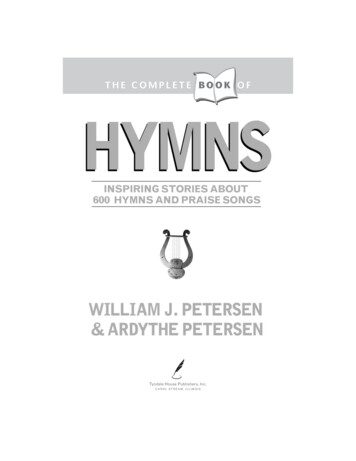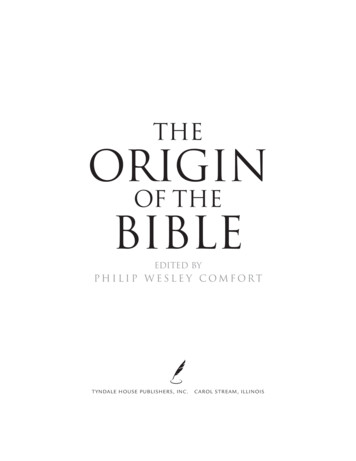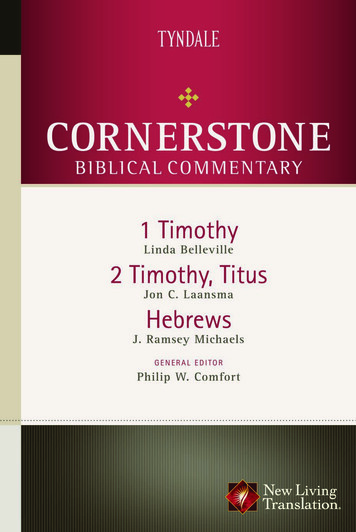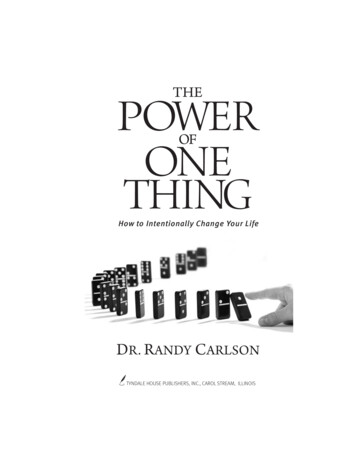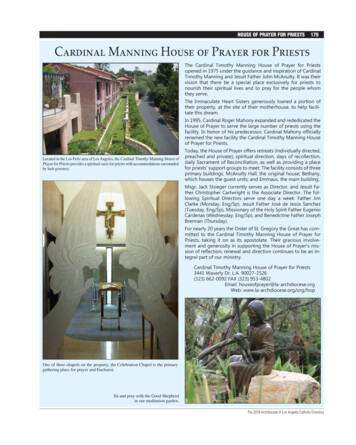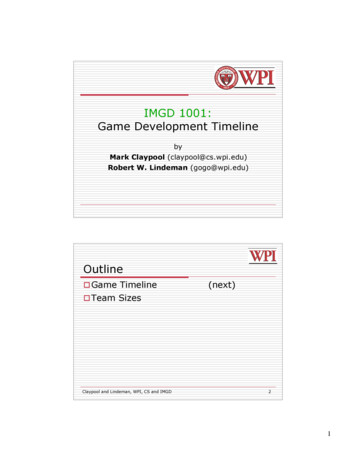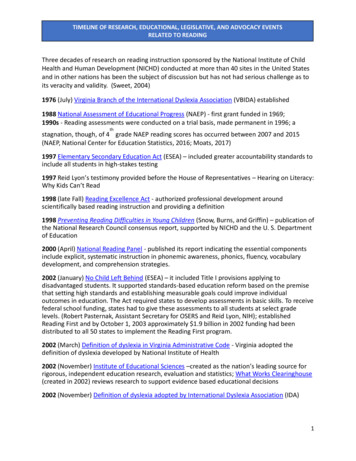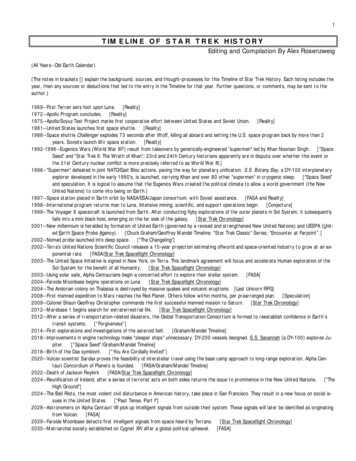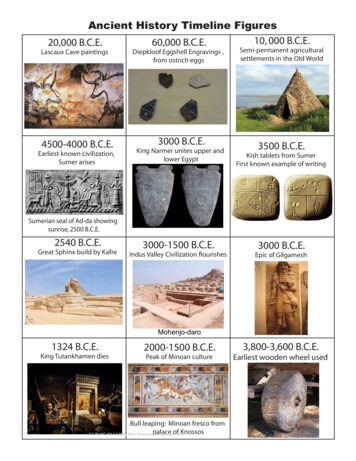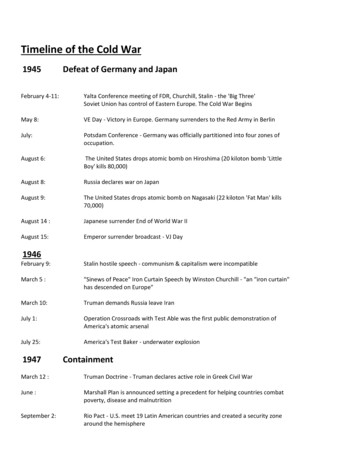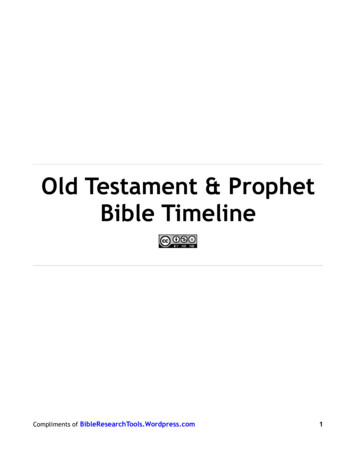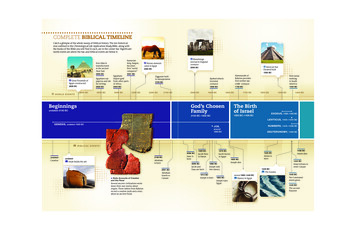
Transcription
COMPLETE BIBLICAL TIMELINECatch a glimpse of the whole sweep of biblical history. The ten historicaleras outlined in the Chronological Life Application Study Bible, along withthe books of the Bible you will find in each, are in the center bar. Significantworld events are above the bar, and biblical events are below it.Sumerianking, Sargon,becomesfirst “worldconqueror”Iron objectsmanufacturedin the ancientNear East2500 BCGreat Pyramids ofEgypt constructedEgyptians usepapyrus and inkfor writing2630 BC2500 BC2400 BC260022606600600 BCBC2500 BCHorses domesticated in Egyptestimated2000 BC2300 BCMexican SunPyramid built1500 BC2331 BCEgyptiansimport goldfrom other partsof AfricaWORLD EVENTSStonehengeerected in England2400 BCZiggurats builtin MesopotamiaSpoked wheelsinvented2100 BC2300 BC2200 BCHammurabi ofBabylon providesfirst written lawcodeestimated1900 BC2100 BCBeginningsundated–2100 BC2000 BCFirst metalworkingin SouthAmericaestimated1750 BC1900 BC1800 BC1700 BCGod’s ChosenFamilyThe Birthof Israel2100 BC–1800 BC1800 BC–1406 BC1440 BC1600 BC1500 BC1400 BCEXODUS, 1500 – 1445 BCLEVITICUS, 1445 – 1444 BCGENESIS, undated–1805 BCNUMBERS, 1445 – 1406 BCJOB,around1900 BCDEUTERONOMY, 1406 BCBIBLICAL EVENTS2066 BCundatedCreation2166 BCundatedAbrahamis bornNoah builds the ark2091 BCEarly Accounts of Creationand the FloodSeveral ancient civilizations wrotedown their own stories aboutorigins. These tablets from Babylonrecord a creation myth and a storyabout an ancient flood.S0-Front.indd A34-A35Abrahamtravels toCanaanIsaac isborn1929 BC1876 BCJacob fleesto HaranJacob movesto Egypt1406 BC1526 BC1805 BC2006 BC1898 BCJacob andEsau are bornJoseph soldinto slaveryMoses diesMoses isborn1443 BCJoseph diesIsrael refuses toenter Canaan1446 BCThe Exodus1915 BCJoseph is bornaround 1800–1446 BC1885 BCJoseph rulesEgyptSlavery in Egypt1445 BCTen Commandments given1445 BCThe secondPassover9/10/2012 1:23:24 PM
Judeabecomesa RomanprovinceTiberiussucceeds CaesarAugustus asRoman emperorAD 6AD 1AD 43Zealots inJudea rebelagainst RomeCaligulabecomesthe RomanemperorHerodAgrippaappointedking ofJudeaClaudiusbecomesthe RomanemperorAD 7AD 37AD 40AD 41AD 1AD 10EmperorClaudiuspoisoned byorder of hiswifeLondon is foundedAD 14Saddles first used inEuropeRome begins constructionon the ColosseumPainting on canvasAD 20WORLD EVENTSAD 30AD 40Jesus ChristThe Church6 BC– AD 30AD 30– presentAD 66AD 75AD 54RomansbeginusingsoapNerobecomesthe RomanemperorAD 50AD 54AD 50Fire burnsRome, NeroblamesChristiansChina openssilk trade withthe WestAD 64AD 68AD 74AD 601 COR, AD 53AD 70PHIL, AD 61AD 80AD 90AD 1001 JOHN, between AD 80–901 TIM &TITUS, AD 62REVELATION, AD 952 TIM &1 PETER, AD 64ACTS, AD 30 – 60JAMES, AD 48COL,PHLM,& EPH,GAL, AD 492 PETER, ADD 65AD 601 & 2 THES,JOHN, AD 26 – 30Domitianbecomes theRoman emperor2 & 3 JOHN, around AD 902 COR &ROMANS,MATTHEW, 6 BC – AD 30MARK, AD 26 – 30AD 79AD 81AD 54LUKE, 6 BC – AD 30Mount VesuviuseruptsRomansdestroy areligiouscommuneat QumranHEBREWSS&JUDE, aroundund AD 66AD 50BIBLICAL EVENTS4 BCAD 5?AD 35AD 51Herod theGreat diesPaul isbornSaul’s conversionon the DamascusroadPaul begins Paul inhis thirdprison inmissionary CaesareajourneyAD 266 BCJesus is bornAD 6Jesus visits Templeas a boyJohn theBaptistbegins hisministryAD 30Jesus is crucifiedAD 27AD 46Paul beginshis firstmissionaryjourneyAD 29S0-Front.indd A42-A43Theconversionof CorneliusAD 49TheJerusalemCouncilJesusbeginshisministryJohn theBaptist isbeheadedAD 40AD 64AD 57AD 62PaulPaul is martyredreleasedAD 70from prisonRomein RomedestroysysJerusalememMasadaAD 59Paul’s voyage to RomeAD 73Jews commitmass suicide atMasada whileunder RomanattackAfter Rome destroyedJerusalem in 70 AD, a smallgroup of Jewish nationalistsdug in at the rugged fortress ofMasada, where they remainedfor three years until theRomans’ siege finally brokethrough the stronghold.AD 30The Holy Spiritdescends on Pentecost9/10/2012 1:27:05 PM
BOOKSMATTHEWMARKLUKEJOHNACTSJesus ChristJfrom the time his people, the people of Israel, had returnedfrom exile some five hundred years earlier. Politics, culture,language, and the religious practices in Israel had all undergone great shifts. The time was ripe for God to send his Son intothe world to be the Messiah, Savior, and King. But he wouldn’tcome in the way that everyone expected.Israel had been waiting for theirMessiah, and there were manyexpectations about what he woulddo for them and how it would look.He was supposed to be a mightyleader who would reestablish Israel’shold on the land God had given totheir ancestor Abraham, expellingthe Romans and recalling the gloryof the age of David and Solomon.The Messiah was expected to bethe climax of Israel’s story, theultimate fulfillment of all God’s15 BC10 BCpromises to his people. Nobodyexpected the Messiah to come asthe baby of a humble peasant girlfrom a small, unimportant town inGalilee. Nobody expected him togather a small group of disciplesand walk around the country tellingstories and challenging the religiousauthorities.But Jesus is the climax of God’sstory! He is the ultimate fulfillmentof all God’s promises to his people!The four Gospels tell the story of how5 BCAD 1AD 5AD 10TIMELINEROME6 BCTO:AD 30and eternal life—far more than the meagerearthly kingdom they were hoping for.In order to understand the story of Jesusthe Messiah, we need to get the lay of the land.Who were the key people and social structures in Israel at this time? Where and withwhom did Jesus spend his time? Who werethe people who flocked to see him? Whowere the ones threatened by his popularity?PEOPLE & CULTUREGreek Influence. A few centuries earlier, the GreekEmpire had conquered most of the known world, andalong with their rule they brought their culture and language to the Jewish people. Jesus was born into a worldthat was still heavily influenced by Greek thought, andvirtually everyone would have known the Greek languagein addition to their local language (in Jesus’ case, likelyAramaic).Roman Rule. The Roman Empire was in controlof the entire world of the Gospels, and had been fornearly a century. There were several levels of Romangovernment, as can be seen in the Herod family, PontiusAD 15AD 20AD 25AD 30AD 35AD 40Tiberius Caesar ( AD 14–37)AD 45Claudius Caesar ( AD 41–54)Gaius Caligula Caesar ( AD 37–41)Antipas divorces Aretas’sdaughter and marries Herodias,his brother Herod Philip’s wifeHerod Antipas rules as tetrarchof Galilee and Perea (4 BC – AD 39)JEWISH TERRITORIESHerod the Great as king of the Jews (37–4 BC )LIFE OF JESUSS9-LifeJesusIntro.indd 1254-1255IncarnationJesus’ TeachingJesus’ MiraclesResurrectionOctavian Augustus Caesar (27 BC – AD 14)Annas as high priest ( AD 6–15)Herod Archelaus rules Judea and Samaria (4 BC – AD 6)1254FROM:this man from the margins of Israel’s society displayed God’s power through mightymiracles and through teaching with authority. They tell the story of how this unlikelyMessiah gave the world far more than anymilitary or political or religious leader evercould have. They tell the story of God withus, the eternal Son of God made flesh to liveamong his people and offer them salvationESUS WAS BORN into a world that had changed drasticallyTHEMESDATES6 BCBirth of Jesusin BethlehemAD 6Jesus in the Templeat age 12AD 36Aretas attacks and defeats Herod AntipasPontius Pilate as governor of Judea ( AD 26–36)Caiaphas as high priest ( AD 18–36)about AD 26John the Baptist begins his ministryabout AD 27Jesus begins his ministryHerod Agrippa I ( AD 37–44)AD 44Agrippa diesabout AD 29fromviolentJohn the Baptist is imprisoned, then beheadedillnessPassover, about AD 30Jesus’ death and resurrection12559/10/2012 1:28:17 PM
Pilate, and the Roman soldiers who make appearancesthroughout the Gospels. Rome collected taxes, enforcedpeace (sometimes with brutal violence), and allowedmany religious freedoms that were not always permittedunder Greek rule.Jewish Groups. There were several prominentJewish groups during this period in history. The Pharisees and Sadducees bridged political and religious leadership, the teachers of religious law and priests wereprimarily responsible for the religious life of the people,and other groups such as the Zealots and the Esseneswere radicals—though in very different ways. Zealotswanted to take political power by force, while Essenesseparated themselves from the world in an effort tolive pure lives marked by ritual holiness. OrdinaryJewish people were able to worship regularly in localsynagogues, led by the mainstream religious leadersin their community. They would journey to Jerusalemonly to worship in the Temple for special life events andreligious festivals.John the Baptist. John didn’t really fit into any ofthe major Jewish groups of his day. He was a herald of thecoming Kingdom of God, calling everyone to repentanceand preparing the way for Jesus and his ministry. Manypeople traveled into the wilderness to hear his messageand be baptized, including a number of people who wouldeventually follow Jesus.Jesus and the Disciples. Jesus was born intoan ordinary family and grew up in an ordinary town, buthis life was far from ordinary. He chose a very diversegroup of disciples—some followers of John the Baptist,at least one Zealot, a man who collected taxes for Rome,and a handful of uneducated fishermen. Jesus taughtthese disciples what it meant to follow him and preparedthem to be his ambassadors on earth after his resurrection and ascension.BOOKS IN THIS SECTION“Life of Jesus” versus “Gospels”We need to remember that the story ofJesus’ life is given to us in four canonical Gospels—literally accounts of the“Good News.” As important as it is to understandthe events of Jesus’ life and see them in chronological order, ultimately God gave us the Gospels sothat we would be able to hear his Good News withclarity. Rearranging the Gospels into chronological order can sometimes highlight places whereindividual Gospel writers have placed a particular story out of chronological order to highlight1256S9-LifeJesusIntro.indd 1256-1257a theological truth about Jesus and his purposes.So pay attention to parts that seem to be locateddifferently in one Gospel compared to another. Itmay indicate something about the different Gospelwriters’ goals.You also might notice some differences in theway a particular story from Jesus’ life is told, especially when the accounts from different Gospelsare placed together as they are in the Chronological Life Application Study Bible. Several thingsshould be kept in mind as you notice the differences: (1) Different people often notice different details when witnessing the same event; thatdoesn’t mean either account is wrong. (2) Jesus’ministry covered over 1,000 days, and he probablyrepeated his teachings at multiple times in variouslocations. It is possible that what has been identified as a parallel between two Gospels is actually acase where two Gospels actually record only similar events or teachings. (3) The order of events (andthe identification of their parallels) reflects thedecisions of our editors and is not inspired, unlikethe text of the Gospels. Feel free to question ourdecisions and compare them with other optionsand possibilities.MATTHEWMatthew (Levi), a former tax collector whobecame one of Jesus’ 12 disciplesMARKAUTHOR:AUTHOR: John Mark. He was not one of the 12 disciples,AUDIENCE: Jewsbut he accompanied Paul on his first missionary journey(Acts 13:13) and is traditionally associated with Peter.PURPOSE: To prove that Jesus is the Messiah, the eternalAUDIENCE:Christians in Rome, where the Gospel wasKingwrittenDATE WRITTEN: Approximately a.d. 60–65PURPOSE: ToMatthew is filled with messianiclanguage (“Son of David” is used throughout) and Old Testament references (53 quotes and 76 other references).This Gospel’s purpose was to present the clear evidencethat Jesus is the predicted Messiah, the Savior.SPECIAL FEATURES:DATE WRITTEN: Approximately a.d. 55–60SPECIAL FEATURES: Mark was probably the first Gospelwritten. The other Gospels quote all but 31 verses of Mark.Mark records more miracles than any other Gospel.LUKELuke, a doctor (Col 4:14), a Greek (Gentile)Christian. He is the only known Gentile (non-Jewish)author in the New Testament. Luke was a close friendand companion of Paul. He also wrote Acts, and the twobooks go together.AUTHOR:AUDIENCE: Theophilus and other GentilesPURPOSE: Topresent an accurate account of the lifeof Christ, and to present Christ as the perfect humanand SaviorDATE WRITTEN: About a.d. 60SPECIAL FEATURES: This is the most comprehensive ofthe Gospels. The general vocabulary and writing styleshow that the author was educated. He makes frequentreferences to illnesses and diagnoses. Luke stressesJesus’ relationship with people; emphasizes prayer,miracles, and angels; records inspired hymns of praise;gives a prominent place to women.present the person, work, and teachingsof JesusJOHNJohn the apostle, son of Zebedee, brother ofJames, called a “Son of Thunder”AUTHOR:AUDIENCE: New Christians and searching non-ChristiansPURPOSE: To prove conclusively that Jesus is the Son ofGod and that all who believe in him will have eternal lifeDATE WRITTEN: Probably a.d. 85–90Of the eight miracles recorded,six are unique (among the Gospels) to John, as is the“Upper Room Discourse” (John 14–17). Over 90 percentof John is unique to his Gospel—John does not containa genealogy or any record of Jesus’ birth, childhood,temptation, transfiguration, appointment of the disciples, nor any account of Jesus’ parables, ascension, orgreat commission.SPECIAL FEATURES:For book information on ACTS, see the introductionto The Church, p. 1505.12579/10/2012 1:28:18 PM
also many Gentiles and Roman military personnel in thisregion, which was at Israel’s northern border.MEGATHEMESJesus Christ: King, Messiah, Servant, Savior, Son of God. In each of the four Gospels, JesusChrist is the central focus, but each Gospel highlightsa slightly different aspect of his significance. Matthewpresents Jesus as th
cal Life Application Study Bible. Several things should be kept in mind as you notice the differ-ences: (1) Different people often notice differ-ent details when witnessing the same event; that doesn’t mean either account is wrong. (2) Jesus’ ministry covered over 1,000 days, and he probably repeated his teachings at multiple times in various
